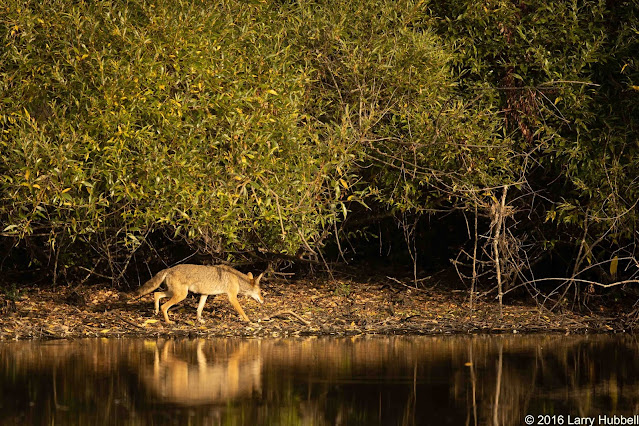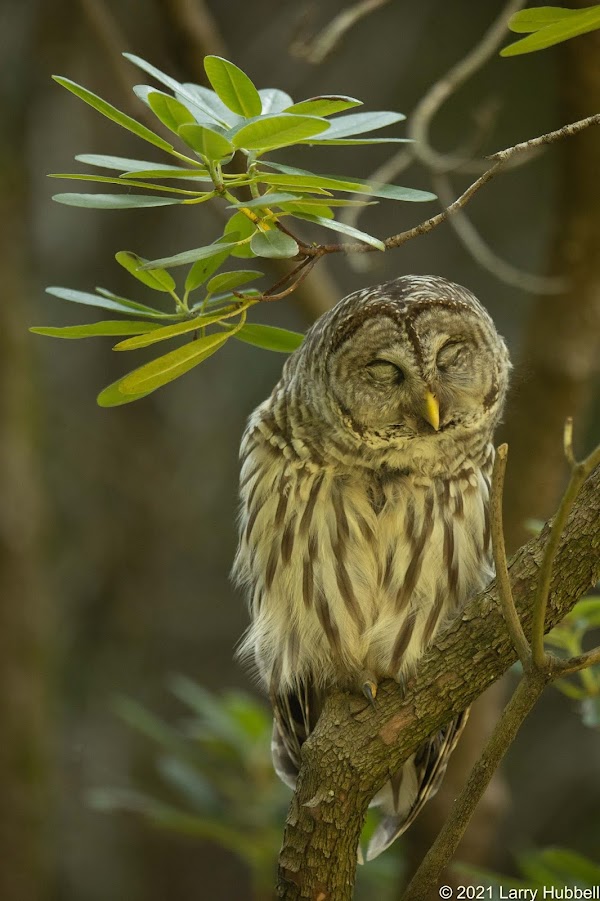Last week, I saw this full-sized Osprey circling over the water next to the Union Bay Natural Area. To catch the fish, that they love, Osprey dive headfirst - as deep as three feet. So, patrolling the shallow water along the shore makes sense. Plants grow well next to the water. Insects find food in the lush foliage and occasionally fall. Struggling insects attract fish to the surface, which makes the fish easy targets for the Ospreys.
The faint thin "necklace" of brown indicated this Osprey was most likely a female. The nearly perfect symmetry and the virtually pristine state of its feathers made me suspect it was a first-year bird.
To the west, on a light pole above the UW baseball field, I could hear and barely see another Osprey. The solid darkness of its outer wing confirmed this was a mature bird.
When the first Osprey passed near the light pole, I noted that the two birds accepted each other's presence without incident. I also saw the small rows of white edging, momentarily visible on the top of the flying bird's wings. This helped to confirm it was a first-year bird.
It seemed likely that these two were family members and most likely from the nest just to the north.
In April, I saw an Osprey stop to eat a fish at the nest above IMA Field 3. March and April are when most Ospreys return to Washington. They are no doubt hungry after flying 2000 miles from their wintering waters in Mexico.
For the third year in a row, Ospreys have nested and raised young on this light pole. Click Here to see last year's photos.
In July, I caught a few photos of the female (most likely Hope) and her two young - while they were still in the nest. The second young bird is mostly hidden by the sticks on the right.
If we zoom into the photo we can see the different colors of their irises'. The adult's irises are yellow while the young's are orange. This would be impossible to see with the naked eye, at least for me.
I find it mysterious that Cooper's Hawks eyes shift from very pale to orange to red with age, while Osprey's go from orange to yellow as they mature. Almost everything in nature seems to exist for a reason.
Do their lighter eyes help mature Osprey to see fish in the water? Do darker eyes help the adult Cooper's Hawks find food in the forest? If both of these happened to be true then why not start out with eyes of the optimal color? Could it be that the color changes exist to indicate their youth to other more mature birds? However, in both cases, there are much more obvious signs of their youth.
For example, an hour later, I observed this young Cooper's Hawk. Its youth is very clearly indicated by the vertical stripes on its chest.
Shortly thereafter a mature Cooper's Hawk arrived, with the obviously different horizontal barring on the chest.
This 2016 photo clearly displays the difference between the adult Osprey's purely dark outer feathering and its young offspring whose dark outer feathers were tipped with white edges. The subtlety of the iris color differences seems redundant. I suspect there may be something more that we do not know.
In this particular case, the iris color difference is almost impossible to see. Why? Since the young bird was flapping its wings, I suspect both birds involuntarily covered their irises with their nictitating membranes. These are partially translucent coverings that protect their eyes in moments when they might be easily damaged. These membranes also reduce our perception of their eye colors.
I find the mysteries and adaptations of nature are wonderfully enthralling and mystifying. Here is another example.
Just before seeing the Cooper's Hawks, I noticed this Coyote patrolling the shore of the Central Pond in the Union Bay Natural Area.
For a moment it started to explore the underbrush.
Immediately, the young Cooper's Hawk abandoned its hunting and flew up to an overhead branch.
The hawk circled around a few more times apparently agitated by the Coyote intrusion.
It finally settled down once again, but it stayed in the treetops.
Below, a second Coyote passed by.
I have always thought of Coyotes as being fairly similar in their markings. Apparently, that is not totally true. Did you notice any differences between the two?
The first Coyote had a dark tip on its tail.
The second had a white tip. This seems unlikely to be a functional signal of youth due to the location. Perhaps, it is just a random mutation with no impact on the survival of the individuals. A Google search of images shows neither white nor black is unusual on a Coyote's tail.
Rather than a sign of youth, maybe the whitetail on the Coyote is actually a sign of age? With humans and even dogs, white hair on the face or head is a clearly visible sign of age. Still, white on the tip of the tail would generally be hidden during a confrontation and so it would seem to be of little value. Actually, it might even be counter-productive for a Coyote to signal its advancing age.
On the other hand, if the color of an animal's tail has no impact on survival why do we have a species of White-tailed Deer and another nearby species of Black-tailed Deer in the Pacific Northwest?
Slightly to the south a young Green Heron, hunted and preened, seemingly obvious to the passing Coyotes and the flights of the young Cooper's Hawk.
Young Green Herons have little white triangles on their feathering which disappear as they mature. By the way, I believe August and September are the optimal months for seeing Green Herons on Union Bay. I recommend bringing binoculars and closely examining the lily pads.
Surprisingly, the young Cooper's Hawk flew almost directly in my direction. I have learned to look for anything that might explain sudden changes in behavior.
I turned and looked in the direction of the hawk's flight. A perched Merlin seemed to be its likely focus. In this photo, I believe the Merlin was in turn focused on another bird that was passing overhead.
Soon the approach of the Cooper's Hawk caught the Merlin's attention.
Momentarily, the Merlin abandoned the tree. However, it soon returned. For a time, both birds sat in the tree. This was interspersed with moments when the two chased each other out over the water. Their interaction seemed almost playful.
I did catch this photo of the young Cooper's Hawk apparently trying to intimidate the Merlin. On average Cooper's Hawks weigh about twice as much as Merlins. However, Merlins belong to the Falcon family and I suspect they can fly circles around Cooper's Hawks.
Shortly, thereafter the adult Cooper's Hawk showed up and the Merlin abandoned its "playtime". My first thought was that the adult hawk was one of the parents from the nearby Cooper's Hawk nest - checking up on its young.
However, a closeup of the bird's leg revealed, unlike the local adult Cooper's Hawks, this bird was unbanded. Since it was not a parent of the young hawk, I wondered why had it approached the other two birds? Why did it come and sit in the same tree? Was it looking for food?
I find that being mystified and impressed by the behavior and beauty of the creatures around us is particularly refreshing in these times of uncertainty.
Have a great day on Union Bay...where nature lives in the city and Black Birders are welcome!
Larry
ps: Click Here for another perspective on canine colors.
Going Native:
Each of us, who breathe the air and drink the local water, needs to watch and protect our local environment. Native plants and trees encourage the largest diversity of lifeforms because of their long intertwined history with our local environment and native creatures. I have been told that even the microbes in the soil are native to each local landscape. I hope we can inspire ourselves, our neighbors, and local businesses to respect native flora and to support native wildlife at every opportunity. I have learned that our most logical approach to native trees and plants (in order of priority) should be to:
1) Learn and leave established native flora undisturbed.2) Remove invasive species and then wait to see if native plants begin to grow without assistance. (If natives plants start on their own, then these plants or trees are likely the most appropriate flora for the habitat.)3) Scatter seeds from nearby native plants in a similar habitat.4) If you feel you must add a new plant then select a native plant while considering how the plant fits with the specific habitat and understanding the plant's logical place in the normal succession of native plants.
My intention in my weekly post is to include at least one photo each week and visually challenge us to know the difference between native and non-native lifeforms.
Also, Jane Lundin has created a small package, with a lot of critical information that looks quite handy, and light, for backpacking in the mountains in Springtime. It is titled, Mountain Wildflowers of Washington.)
Another idea that integrates perfectly with living in harmony with nature is the concept of Forest Gardening. Apparently, Native Americans collected and nurtured dense multi-layered gardens of native herbs, plants, shrubs, and trees that produced food and herbal medicines. Even after 150 years of no maintenance, the gardens are essentially intact and the diversity of life remains significantly higher than in the surrounding forests. Click Here to learn more.
What are the four species of plants in front of this tree trunk? Is each native to Union Bay?
Scroll down for the answer.
****************
Starting right in the middle of the trunk:
Low Oregon Grape - Mahonia nervosa
Up and to the left:
Beaked Hazelnut - Corylus cornuta
Up and to the right:
Indian Plum - Oemleria cerasiformis
Down and to the right:
Salal - Gaultheria shallow
These plants are all native to Union Bay and the Pacific Northwest. As is the tree:
Western Red Cedar - Thuja plicate
.
*****************
The Email Challenge:
In response, I have set up my own email list. With each post, I will manually send out an announcement. If you would like to be added to my personal email list please send me an email requesting to be added. Something like:
Larry, I want to see more of nature. Please add me to your personal email list.
Thank you for your patience and interest!
My email address is: LDHubbell@Comcast.Net
*******************
Final photos:





















































